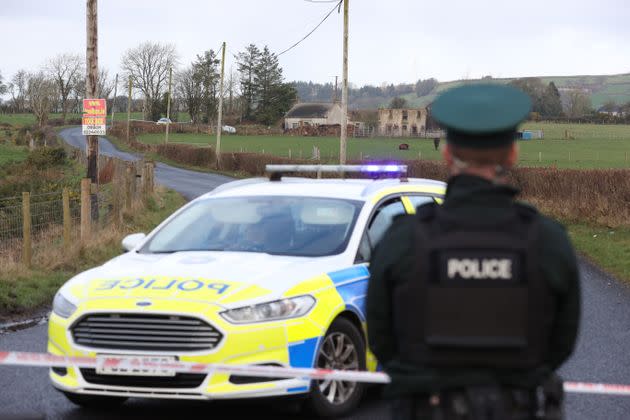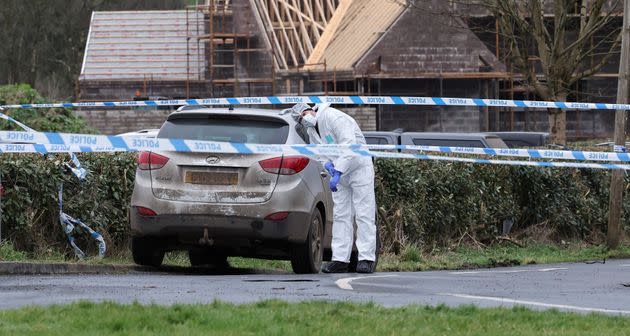Northern Ireland's Terror Threat Level Just Increased. What Does That Mean?

A cordon is near to the sports complex where off-duty PSNI Detective Chief Inspector John Caldwell was shot
MI5 has just increased the terror threat level in Northern Ireland from “substantial” to “severe”.
Concerns around the region have been circulating at the top of the news agenda for some time now, meaning this significant change is drawing particular attention.
Here’s what you need to know.
What does the terror threat level mean?
Threat levels offer a general indication of how likely a terrorist attack is that area.
There are five levels in total:
Low: An attack is highly unlikely
Moderate: Attack is possible, but not likely
Substantial: An attack is likely
Severe: An attack is highly likely
Critical: An attack is highly likely in the near future
The previous level in Northern Ireland was “substantial”, which meant an attack was likely.
Now, it’s “severe” – so an attack is highly likely – but the public have been urged to “remain vigilant, but not be alarmed”, and to report any concerns to Northern Ireland police (PSNI).
MI5, the security service meant to keep the UK safe, decides what the level is for this region of the UK.
Meanwhile, the threat level for the UK from international terrorism is set by Joint Terrorism Analysis Centre.
The threat level for the rest of the UK is still “substantial”.
Why has it changed?
Northern Ireland secretary Chris Heaton-Harris explained that the situation in the region is “constantly monitored” and reviewed – and that, unlike with the rest of the UK, the MI5 makes the decision for NI “independently of ministers”.
Writing in a post on the gov.uk website, the minister explained: “In recent months, we have seen an increase in levels of activity relating to Northern Ireland Related Terrorism, which has targeted police officers serving their communities and also put at risk the lives of children and other members of the public.”
However, he said these attacks “have no support”, pointing to the stunned public reaction to the attempted murder of DCI Caldwell last month.
The inspector was shot in February by masked gunmen in County Tyrone, after coaching a local football club, in front of his young son. He remains critically ill in hospital, although in a stable condition.
Thirteen arrests have been made over his attempted murder.
Heaton-Harris continued: “A small number of people remain determined to cause harm to our communities through acts of politically motivated violence.”
In response to the terror threat change, Chief Constable of the PSNI, Simon Byrne, said: “We will relentlessly pursue those who seek to cause harm and terrorise our communities, and attack my officers and staff, and I pay tribute to them as they continue to deliver for our communities.”
Others believe there aren’t enough police officers around in the first place.
Sir Jeffrey Donaldson, leader of Belfast’s Democratic Unionist Party, said: “The government made a commitment to help fund 7,500 officers in the PSNI but have not yet made good on that promise.”

John Caldwell was shot, in Omagh, Northern Ireland February 23, 2023.
What else do we need to know about Northern Ireland?
Around 25 years ago, the Belfast (or Good Friday) Agreement transformed Northern Ireland and seemingly put an end to The Troubles.
The region had been divided between unionists, who wanted NI to be with Great Britain, and nationalists, who wanted to unite with the Republic of Ireland.
Part of the landmark deal meant the Northern Ireland executive can only work if parties from both sides of the political spectrum agree to work together.
While the agreement is still very much in place today, Brexit has cast a shadow over the region because the DUP – the main Unionist party – is refusing to take its seats in Stormont. It believes NI is too isolated from the rest of the UK post-Brexit.
Then, there’s been a resurgence in the so-called new Irish Republican Army (IRA), with more violence erupting. The dissident group are thought to be behind the attack on Caldwell last month.
That’s where Rishi Sunak’s new Windsor Framework comes in. Downing Street hopes that this will help rectify any remaining tensions – even though the DUP has said it will still vote against it.
US president Joe Biden is planning to visit Northern Ireland to mark the 25th anniversary of the Good Friday Agreement in April.
He has Irish roots, and has made it exceptionally clear that peace in the region is of paramount importance to him, especially in the post-Brexit era.
Worries around stability in the region have particularly fluctuated since the EU referendum in 2016 – and this is particularly clear in the terror threat level.
Having been at “substantial” since 2010, it then increased briefly to “severe” before going down again – and now it’s increased once more.

 Yahoo News
Yahoo News 